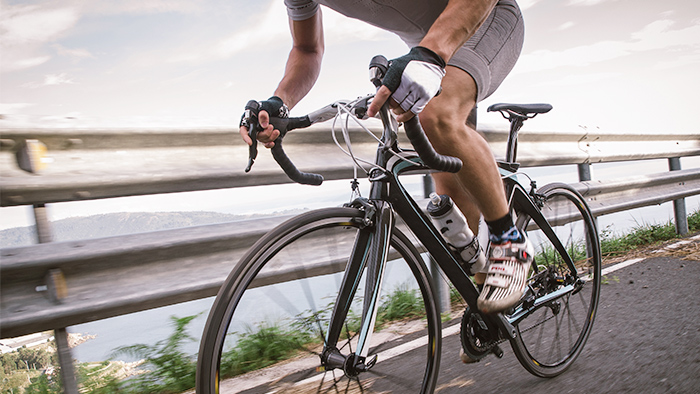I love the challenge and reward of hilly races. But, I live (and train) in an elevation-deprived area so many of my key workouts involve simulating hill training in order to get race-ready.
You’d think that maybe I would give up on hilly adventures. But, that isn’t the case. I’ve raced on some of the most iconic hilly terrain— from IRONMAN Lake Placid to running Rim-to-Rim-to-Rim in the Grand Canyon. It’s possible with some creative twists to training.
Do you live in an elevation-deprived location, but hear the mountains calling? Then, this article is for you! Let’s cover some options for the bike and run.
Your training should prepare you to meet the demands of your event. What do you need to tackle hills? Strength and cardiovascular fitness. Your general training will support your overall fitness, so our tips focus on building strength – body and mind – for the climb.
How to Simulate Hill Training on Your Bike
For cycling, our hill-specific strength sessions simulate hill training through the use of:
- Bike gears
- Trainer
- Wind
A staple session is the big gear workout, which includes using the front big ring, and a low rear gear. This combo creates resistance, which in turn helps build your strength.
You can modify big gear workouts for indoor or outdoor riding. On the trainer, raise the front wheel slightly to mimic the position of climbing. If you are outside, ride big gear into a headwind; we call this approach the “South Jersey Hills.” If you have a smart trainer, you can ride simulated hilly courses, which will allow you to build strength, which can help you learn how to gear for elevation changes.
We recommend starting with shorter big-gear sets to acclimate the body. For example:
- 5×4 minutes at a moderately hard effort (75- to 85-percent functional threshold power (FTP), or 85 to 95-percent lactate threshold heart rate (LTHR)
- 1- to 2-minute recoveries, easy spin at a higher cadence, 95+ rpms.
- Cadence for the main sets is between 60 and 70 rpms.
For your first big gear session, shoot for a combined work interval of 20 to 25 minutes.
As you progress, increase the length and/or intensity of the sets. Adapt these sessions to match the specifics of your race. For example, if your race has climbs that take 10 or more minutes, build toward 10- and 12-minute sets, just above your race intensity. For shorter climbs or to create anaerobic stress, reduce the duration and work at a higher intensity—at or above your FTP/LTHR.
Longer endurance rides can include “hilly” wind sets, with a series of five to 15-minute big gear sets into a headwind. Recoveries are at least half of the interval time. Include these sets fartlek-style, when the wind conditions allow. Gradually adapt the total big gear riding time to meet the demands of your race.
Bike handling is another key element to success on hilly courses. You want to maximize momentum on rollers, and safety and efficiency on the descents. To improve bike handling overall, you need to ride outside. Practice cornering, as that can be key to fast and safe downhilling. Take the time one weekend (or two!) to travel to a hilly route. Alternatively, you can register for a hilly prep race, which will give you the opportunity work on your handling in a race environment.
How to Simulate Hill Training on the Run
Running, as with cycling, can be strengthened with indoor and outdoor options. These include a combination of:
- Treadmill
- Steps or a stair stepper machine
- Bridges
Treadmills allow for varied hill sessions. To work on force and anaerobic fitness, short sets will do the trick!
The sessions include six to 10 repetitions of one to two-minute hill sprints, with one to three- minute recoveries. For example:
- 6 x 1 minute hard efforts
- 1 minute recovery between each effort
- You can progress to 10 x 90-120 seconds, with 2-3 minute recoveries.
- Incline can be anywhere from 4 to 9 percent.
For an extra challenge, gradually increase the incline across sets, while keeping the same pace. I call these sessions “frog boilers”— just like that little frog in hot water— you won’t realize how much you are “cooking” until you are in the middle of it.
For longer sets that work on muscular endurance and aerobic threshold, try a series of varied sets. For example:
- 2 minutes hard, 2 minutes easy
- 3 minutes hard, 3 minutes easy
- 4 minutes hard, 4 minutes easy
- Then, come back down the pyramid.
- Hard sets are at 5 to 7-percent incline, while the recoveries are at 0 percent incline.
You can turn up the heat on this one by trying to maintain the same pace throughout the entire workout.
Outdoors, you can use steps (such as bleachers at your local high school track) or bridges. One of our favorite workouts for the bridges (or other similar hill) is “Fast Downs,” which works the downhill portion of the run. This workout strengthens your quads, works on your cadence and form, and prepares you for races with significant downhill portions. (Note: This workout should NOT be done if you have knee problems)
“Fast Downs” Workout
Warm up
- 10-15 minutes easy (flat or flat-ish ground)
- 5×20-second strides, 40 seconds easy
Main Set: repeat the following pattern for 30 minutes:
- Run up the bridge/hill at an aerobic effort (80 to 90 percent of LTHR)
- Run down the bridge/hill a little harder than you climbed it, focusing on quick, light cadence. Do NOT let your heel plant. Make sure your foot lands under your center of gravity (not out in front). Use your arms for balance. Form is key!
Cool down: 10 minutes easy run
Start with 30 minutes of repeats. Then, for each additional session, add 10 to 15 minutes. Depending on race specifics, you may top out anywhere from one to two hours of fast down running.
Hilly races offer challenges that bring their own distinct rewards. Don’t let your flatlander status keep you from pursuing them. Go for your big mountain dreams with some strength-based tweaks to your training to simulate hill training so you can arrive fully prepared.



